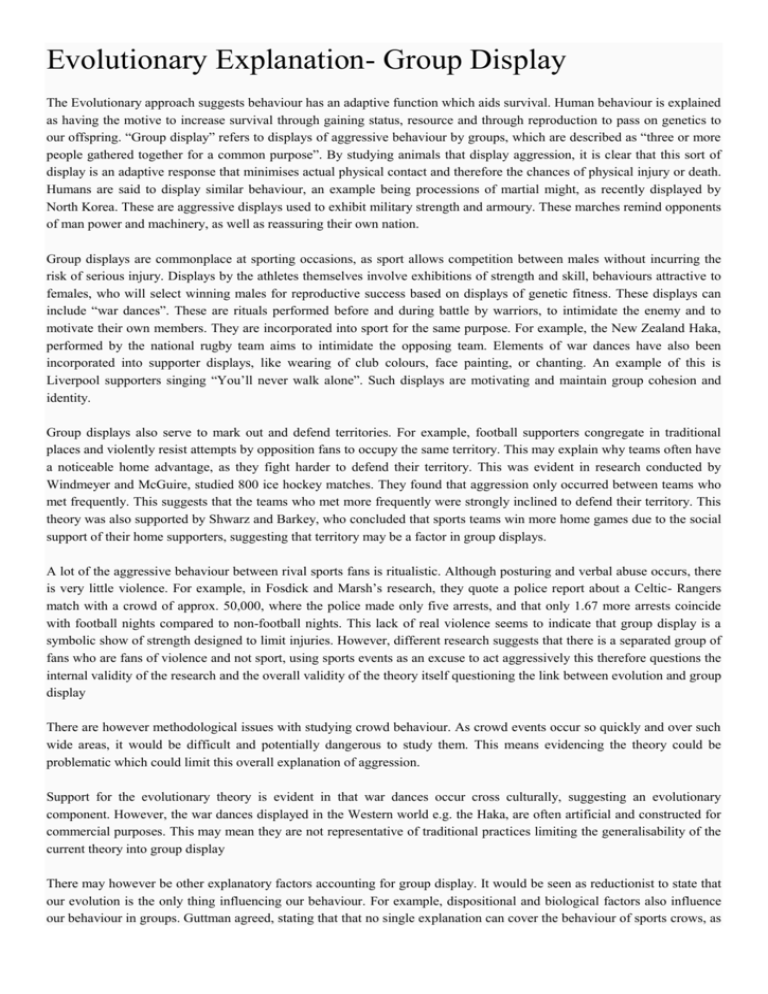File
advertisement

Evolutionary Explanation- Group Display The Evolutionary approach suggests behaviour has an adaptive function which aids survival. Human behaviour is explained as having the motive to increase survival through gaining status, resource and through reproduction to pass on genetics to our offspring. “Group display” refers to displays of aggressive behaviour by groups, which are described as “three or more people gathered together for a common purpose”. By studying animals that display aggression, it is clear that this sort of display is an adaptive response that minimises actual physical contact and therefore the chances of physical injury or death. Humans are said to display similar behaviour, an example being processions of martial might, as recently displayed by North Korea. These are aggressive displays used to exhibit military strength and armoury. These marches remind opponents of man power and machinery, as well as reassuring their own nation. Group displays are commonplace at sporting occasions, as sport allows competition between males without incurring the risk of serious injury. Displays by the athletes themselves involve exhibitions of strength and skill, behaviours attractive to females, who will select winning males for reproductive success based on displays of genetic fitness. These displays can include “war dances”. These are rituals performed before and during battle by warriors, to intimidate the enemy and to motivate their own members. They are incorporated into sport for the same purpose. For example, the New Zealand Haka, performed by the national rugby team aims to intimidate the opposing team. Elements of war dances have also been incorporated into supporter displays, like wearing of club colours, face painting, or chanting. An example of this is Liverpool supporters singing “You’ll never walk alone”. Such displays are motivating and maintain group cohesion and identity. Group displays also serve to mark out and defend territories. For example, football supporters congregate in traditional places and violently resist attempts by opposition fans to occupy the same territory. This may explain why teams often have a noticeable home advantage, as they fight harder to defend their territory. This was evident in research conducted by Windmeyer and McGuire, studied 800 ice hockey matches. They found that aggression only occurred between teams who met frequently. This suggests that the teams who met more frequently were strongly inclined to defend their territory. This theory was also supported by Shwarz and Barkey, who concluded that sports teams win more home games due to the social support of their home supporters, suggesting that territory may be a factor in group displays. A lot of the aggressive behaviour between rival sports fans is ritualistic. Although posturing and verbal abuse occurs, there is very little violence. For example, in Fosdick and Marsh’s research, they quote a police report about a Celtic- Rangers match with a crowd of approx. 50,000, where the police made only five arrests, and that only 1.67 more arrests coincide with football nights compared to non-football nights. This lack of real violence seems to indicate that group display is a symbolic show of strength designed to limit injuries. However, different research suggests that there is a separated group of fans who are fans of violence and not sport, using sports events as an excuse to act aggressively this therefore questions the internal validity of the research and the overall validity of the theory itself questioning the link between evolution and group display There are however methodological issues with studying crowd behaviour. As crowd events occur so quickly and over such wide areas, it would be difficult and potentially dangerous to study them. This means evidencing the theory could be problematic which could limit this overall explanation of aggression. Support for the evolutionary theory is evident in that war dances occur cross culturally, suggesting an evolutionary component. However, the war dances displayed in the Western world e.g. the Haka, are often artificial and constructed for commercial purposes. This may mean they are not representative of traditional practices limiting the generalisability of the current theory into group display There may however be other explanatory factors accounting for group display. It would be seen as reductionist to state that our evolution is the only thing influencing our behaviour. For example, dispositional and biological factors also influence our behaviour in groups. Guttman agreed, stating that that no single explanation can cover the behaviour of sports crows, as they differ so widely e.g. rugby fans may not behave in the same way as football fans. Also the Evolutionary approach cannot explain why some cultures behave in certain ways and others do not. Evolutionary theories for group display are often regarded as speculative. As they cannot be falsified, they cannot be regarded as scientific theories. This may mean that the evolutionary theory does not have as much weight as ones that can be falsified, such as the social learning theory. Also, group displays at sports events may not be conducted as a way of communicating aggression. For example, Grieve found that identification with sports teams was psychologically important in an otherwise transient and insular society, suggesting that group display allows individuals to feel a sense of social identity. However, Dunning argued this, stating that far from being ritualistic and harmless, aggression in sports matches is violent, resulting in many deaths. There is therefore conflicting opinions regarding the evolutionary theory of group display








